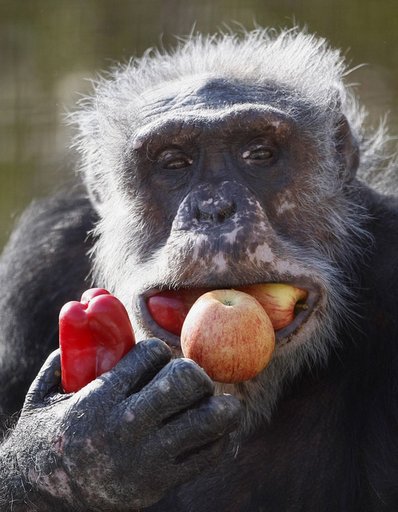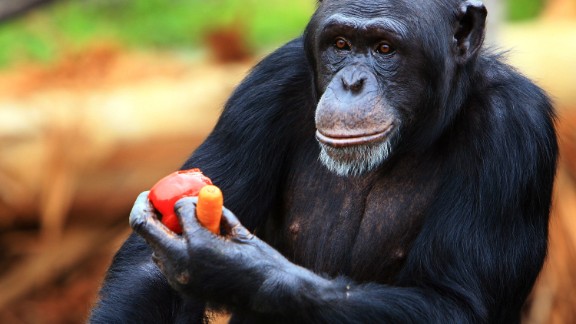

They are capable of using various tools for different purposes. IntelligenceĪfter humans, Chimps are the most intelligent of primates. It is important to note that meat and insects only make up 2 percent of chimpanzee diet. They succeed in this by ganging up and forming effective hunting parties. Their commonest prey are small baboons, colobus monkeys, bushbucks, bush babies, warthogs and blue duikers. Chimps have been observed hunting down other smaller primates and antelopes for food. Though mostly herbivorous, chimps also eat insects, soil, honey and birds. Chimp diet consists of mainly fruits, stems, bark, leaves, seeds and blossoms. After feeding, chimps enjoy taking an afternoon nap. Most feeding is done on tree tops but they also spend time foraging on the ground. Chimps are skillful climbers and use their arms to jump or swing from tree to tree. They start the day at dawn and head straight to areas known to have the best food. Feeding and DietĬhimpanzees spend their time on the ground and also on tree tops. As they age, chimps develop grey hair around the chin or develop bald spots. Chimps in captivity live longer with some reaching 70 years. Most reach 25 years while a few can live for 60 years. The average lifespan of wild chimpanzees is short. They can move on both four legs or upright with arms that are longer than legs. An adult chimp can stand upright reaching a height of about 4 feet and 11 inches. Although they weigh less than humans, chimps are 1.5 time stronger physically. Females can weigh between 27 to 50 kilograms while males weigh up to 70 kilograms. They are covered by either brown or black coats. Physical CharacteristicsĬhimpanzees generally have a bare face, palms, toes and fingers.

Bonobos are restricted to DRC (Democratic Republic of Congo).

They further believe that Chimps and bonobos separated about 1 million years ago. Biologists believe that chimps, bonobos and humans share a common ancestor who lived about 7 million years ago. *International Union for Conservation of Nature is the world’s main authority on the conservation status of species.Chimpanzees and bonobos are the closest relatives to humans. Young chimps will become independent at about six to nine years old, although they will maintain lifelong bonds with their mothers. Infants are completely dependent on their mothers and travel with her on her back or stomach. Tactile communication, such as social grooming, is also vital to reconcile conflicts, ease stress, and develop and maintain bonds between individual chimps.įemale chimpanzees usually give birth to one infant, or occasionally twins. Chimps are quite vocal and use a variety of grunts, squeaks, screams and barks to express different emotions. Males will assert their dominance through displays of aggression and have been known to attack, and even kill, trespassers in their territories.Ĭhimps have a wide repertoire of complex expressions, postures, and vocalisations for communication. Social hierarchies exist for both male and female chimpanzees. Chimps live in a fission-fusion society, meaning they don’t stay together all the time, but form temporary associations with a subset of the group. Now we know that chimps, some birds, and even some fish can make and use tools.Ĭhimpanzees are social, living in communities of up to 150 individuals. Before Jane Goodall’s pioneering studies revealing tool use in chimpanzees, humans believed that toolmaking and use was what made us distinct from other animal species. Sick chimps have also been known to eat potentially medicinal plants.
Chimpanzee diet in captivity live food crack#
They are also known to make and use tools, including stick tools for the extraction of ants, termites, honey and bees stone and wood tools to crack nuts fishing rods created from long branches to fish for algae and sponges made from leaves.

Some even argue that they should be taxonomically categorised as Homo, the same genus as humans.Ĭhimpanzees are highly intelligent, with complex social structures and distinct cultures. There are four recognised sub-species of chimpanzee: the western chimpanzee found in West Africa, the Nigeria-Cameroon chimpanzee found only in Nigeria and Cameroon, the central chimpanzee found in Cameroon and Congo Basin, and the eastern chimpanzee found in Burundi, Central African Republic, Congo, Democratic Republic of the Congo, Rwanda, South Sudan, Tanzania and Uganda.Ĭhimpanzees share about 99% of our DNA, making them the closest living relative of humans.


 0 kommentar(er)
0 kommentar(er)
